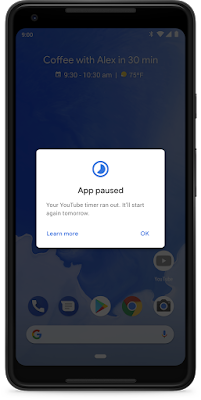Here are six reasons we think you’re gonna like YouTube Music:
- It’s ALL here. Not just music videos, but official albums, singles, remixes, live performances, covers and hard-to-find music you can only get on YouTube.
- Recommendations built for you. A home screen that dynamically adapts to provide recommendations based on what you’ve played before, where you are and what you’re doing. At the gym workin’ on that fitness? Escaping during your commute? The right music is right here, built just for you.
- Thousands of playlists across any genre, mood or activity. That means no matter what kind of music you like, where you are, what you’re doing, or what mood you’re in, you can easily find the right playlist for that moment. Try “House hotlist” to discover the best in house music or “SA’s hip hop hotlist” to get the heart rate going.
- Smart search so we’ll find the song, even if you can’t remember what it’s called. Try “that South African fainting song” or “the song with clicking” - We got you. You can also search by lyrics (even if they’re wrong). It’s “Starbucks lovers,” right?
- The hottest new music. We’ll keep you on top of what’s hot! The hottest videos in the country right now are right there, on their own dedicated Hotlist screen. And our popular YouTube Charts like Top 100 Songs South Africa are available in YouTube Music as playlists so you can keep up with the latest and greatest.
- No internet? No problem. Get YouTube Music Premium to listen ad-free, in the background and on-the-go with downloads. Plus, your Offline Mixtape automatically downloads songs and videos you love just in case you forgot to.
YouTube Premium also launches today
Starting today, you can also upgrade to YouTube Premium, providing members with the benefits of Music Premium, plus ad-free, background, downloads across all of YouTube. Try YouTube Premium free for three months here, R71.99 per month after, R109.99 per month for a Family Plan).
Google Play Music subscribers will automatically receive access to YouTube Music Premium at their current price. Nothing is changing with Google Play Music - you'll still be able to access all of your purchased music, uploads and playlists in Google Play Music just like always.
Get the new YouTube Music from the Play Store and App Store today or check out the web player at music.youtube.com. You can signup for YouTube Premium at youtube.com/premium.
Posted by the YouTube Music Team
====
YouTube Music fait ses débuts en Afrique du Sud : Tout est là.
Du Global Citizen Festival: Mandela 100 diffusé en direct avec pour invitée Beyoncé jusqu’aux vidéos cultes comme «Despacito», « New Rules » et « This Is America », on se connecte à YouTube pour faire partie de la culture musicale et découvrir de nouvelles sonorités.
Mais YouTube a été conçu pour regarder des vidéos, ce qui supposait de jongler entre plusieurs applications musicales et YouTube. Cette époque sera bientôt révolue. Aujourd’hui, nous sommes heureux de présenter YouTube Music en Afrique du Sud.
YouTube Music c’est un nouveau service de musique en streaming qui permet d'écouter de la musique, en plus de la magie de YouTube : rendre le monde de la musique plus accessible et plus personnalisé que jamais. Que vous souhaitiez écouter, regarder ou découvrir, toutes les tendances de la musique sont réunies au même endroit.
- TOUT est là. Pas seulement les vidéoclips mais aussi les albums officiels,les singles, les remix, les concerts en direct, les reprises et de la musique que vous ne trouverez que sur YouTube.
- Des recommandations rien que pour vous Un écran d’accueil qui s’adapte de façon dynamique pour fournir des recommandations en fonction de ce que vous avez écouté précédemment, de l’endroit où vous vous trouvez et de ce que vous êtes en train de faire. En salle de sport workin’ on that fitness? Vous voulez un moment d’évasion pendant vos trajets quotidiens ? Les bonnes musiques sont ici, avec un programme rien pour vous.
- Des milliers de playlists dans tous les genres, quelles que soient votre humeur ou votre activité. Peu importe le genre de musique que vous aimez, où que vous soyez, quelle que soit votre activité ou votre humeur du moment, vous pouvez trouver facilement la playlist qui vous convient. Laissez-vous tenter par les « dernières tendances de la musique house » et découvrez les meilleurs dans ce genre ou la SA hip hop » pour bouger et vous éclater.
- La fonction de recherche intelligente vous permet de trouver la chanson, même si vous ne vous souvenez plus du titre. Essayez « cette chanson sud-africaine dont le refrain invite à faire semblant de s’évanouir » ou « la chanson avec des bruits de clic » - We got you. Vous pouvez aussi faire une recherche sur les paroles (même si ce ne sont pas les bonnes). C’est bien « Starbucks lovers », n’est-ce pas ?
- Les nouvelles musiques les plus tendance Grâce à YouTube Music, restez au top des tendances ! Les vidéos les plus vues du pays sont désormais accessibles, sur leur page dédiée. Sans oublier les YouTube Charts comme le Top 100 des chansons sud-africaines qui sont disponibles sur YouTube Music sous forme de playlists afin de ne manquer aucun des succès les plus récents ni les classiques.
- Vous n’avez pas accès à Internet ? Ce n’est pas un problème. Abonnez-vous à YouTube Music Premium pour écouter vos musiques sans publicité, en arrière-plan pendant vos déplacements, grâce aux téléchargements. De plus, votre Offline Mixtape télécharge automatiquement les chansons que vous aimez, au cas où vous auriez oublié.
Le lancement de YouTube Premium c’est également aujourd’hui
À partir d’aujourd’hui, vous pouvez également passer à YouTube Premium. Ce service propose aux abonnés les avantages de Music Premium, sans publicité, des téléchargements sur l’ensemble de YouTube et un accès aux émissions et aux films disponibles sur YouTube Originals . Essayez YouTube Premium gratuitement pendant trois mois en cliquant ici pour 71,99 rands par mois, puis, R109,99 rands par mois pour un Abonnement famille).
Les abonnés de Google Play Music auront automatiquement accès à YouTube Music Premium au tarif actuel. Rien ne change avec Google Play Music - vous pourrez toujours accéder à toute la musique achetée, aux téléchargements et aux playlists dans Google Play Music.
Accédez à la nouvelle version de YouTube Music via l’App Store et App Storedès aujourd’hui ou essayez le lecteur web à l’adresse suivante music.youtube.com. Vous pouvez vous abonner à YouTube Premium à l’adresse suivante youtube.com/premium.










